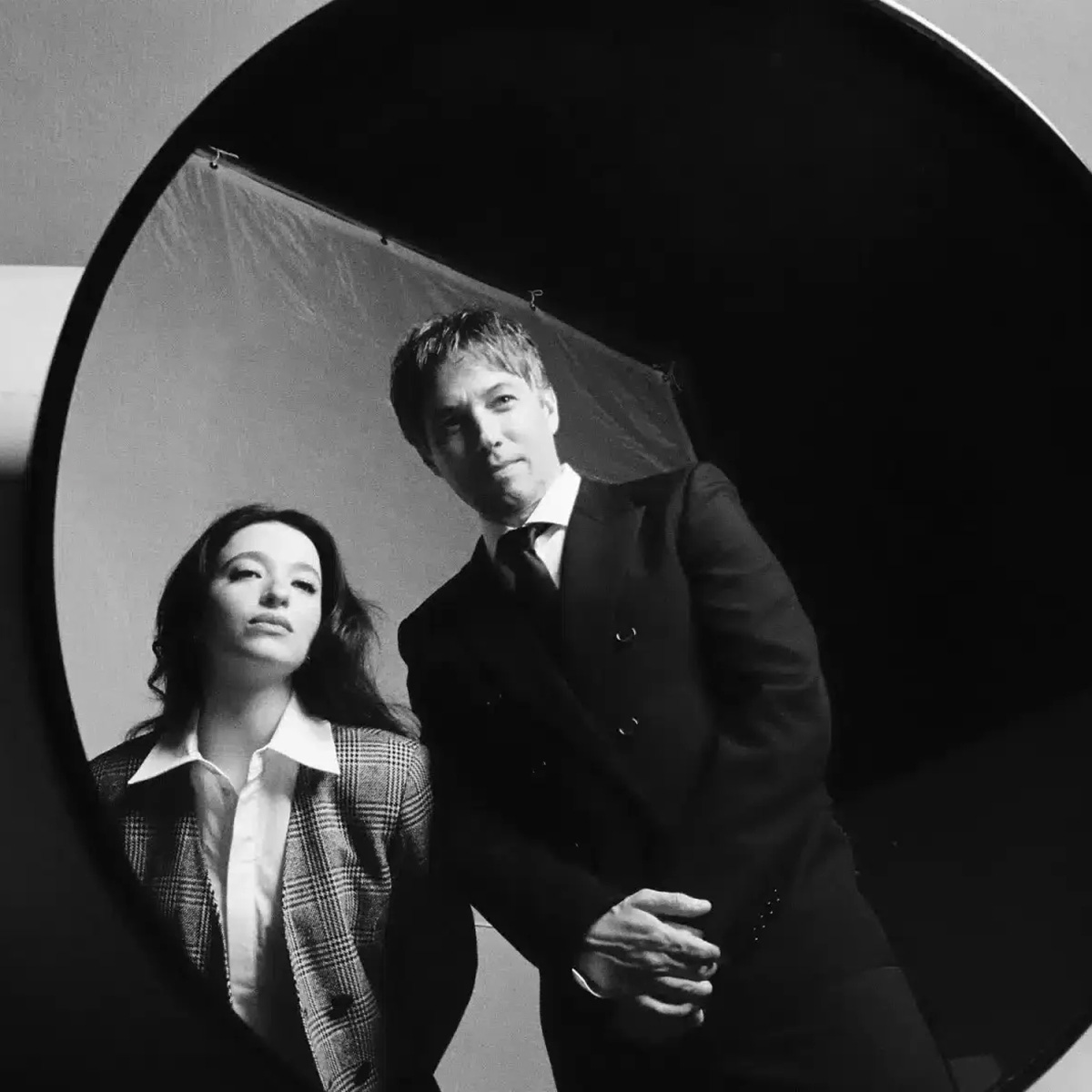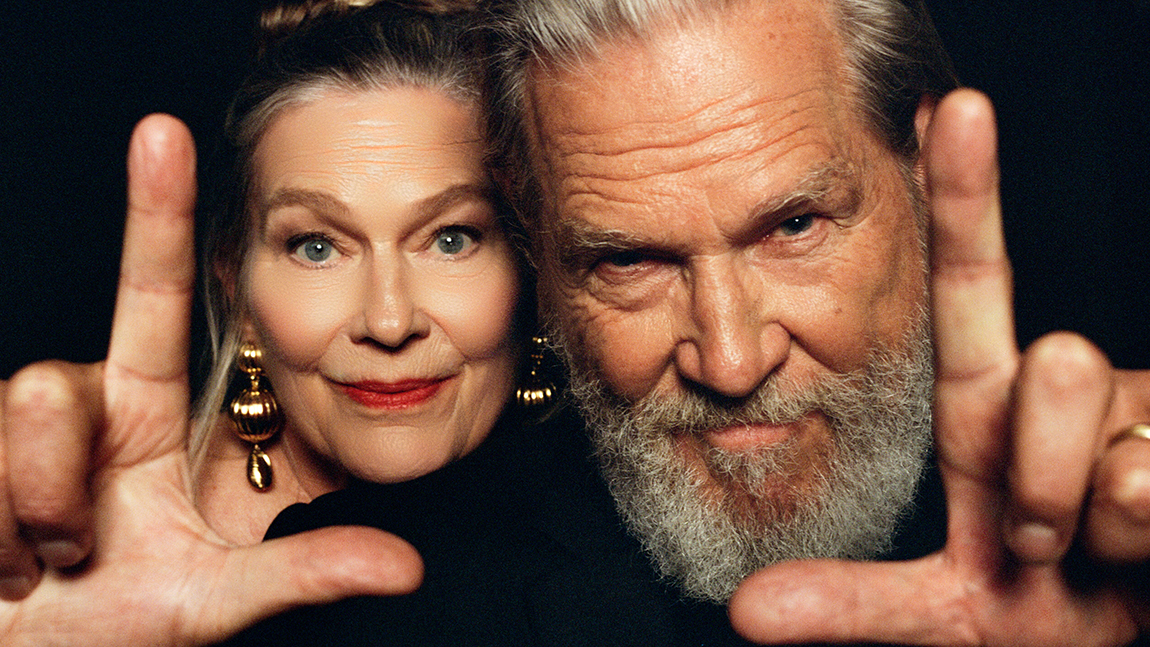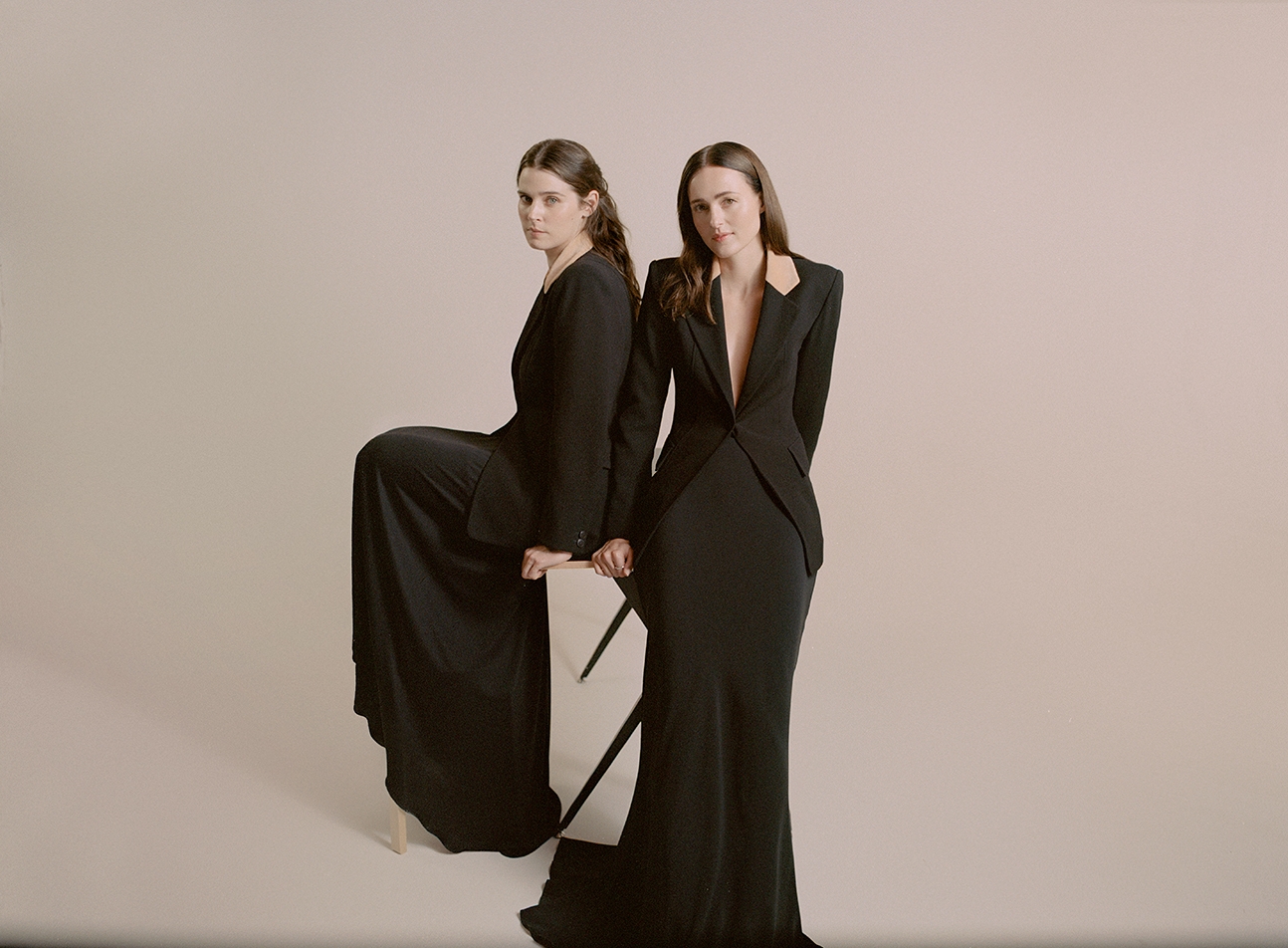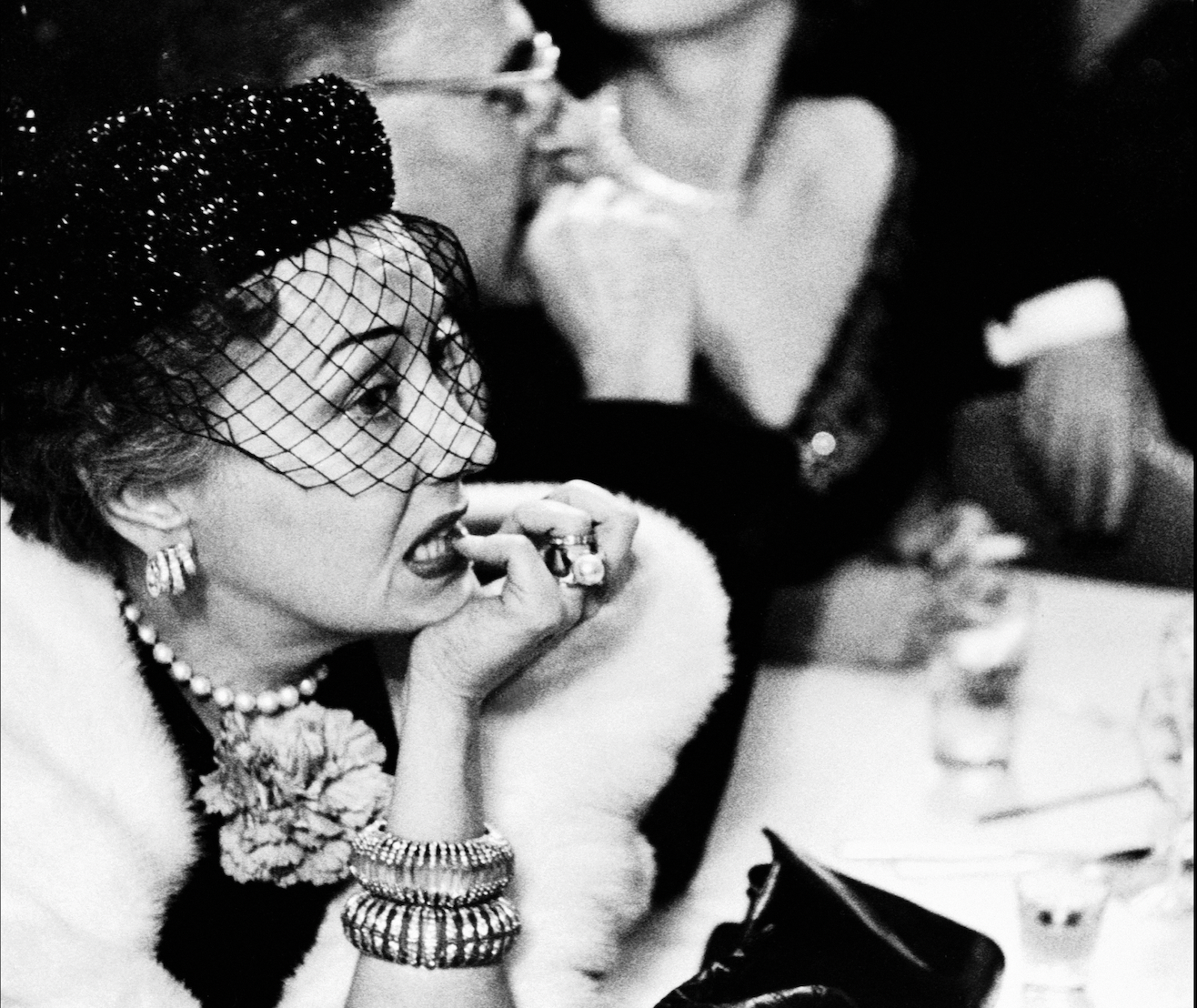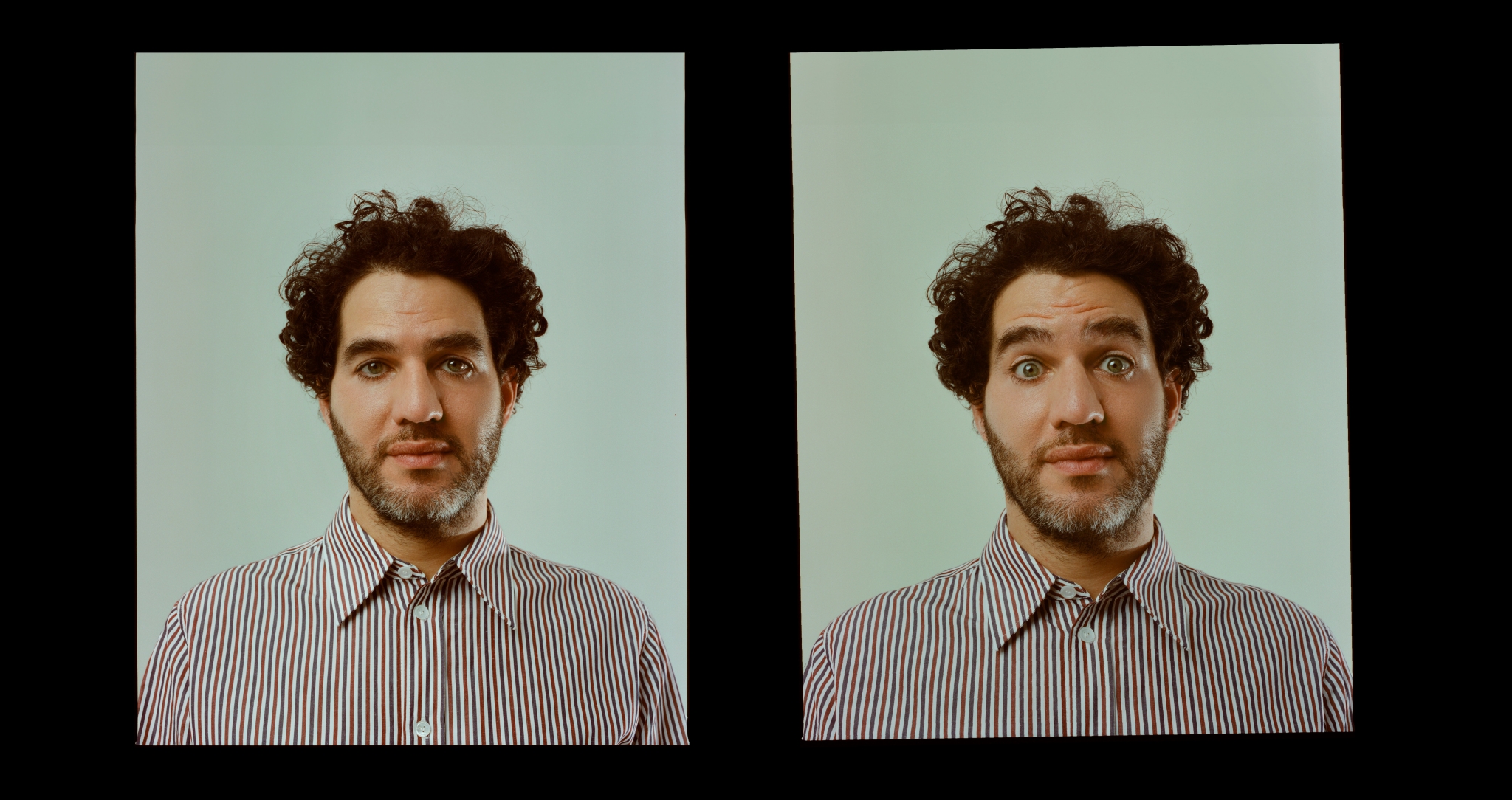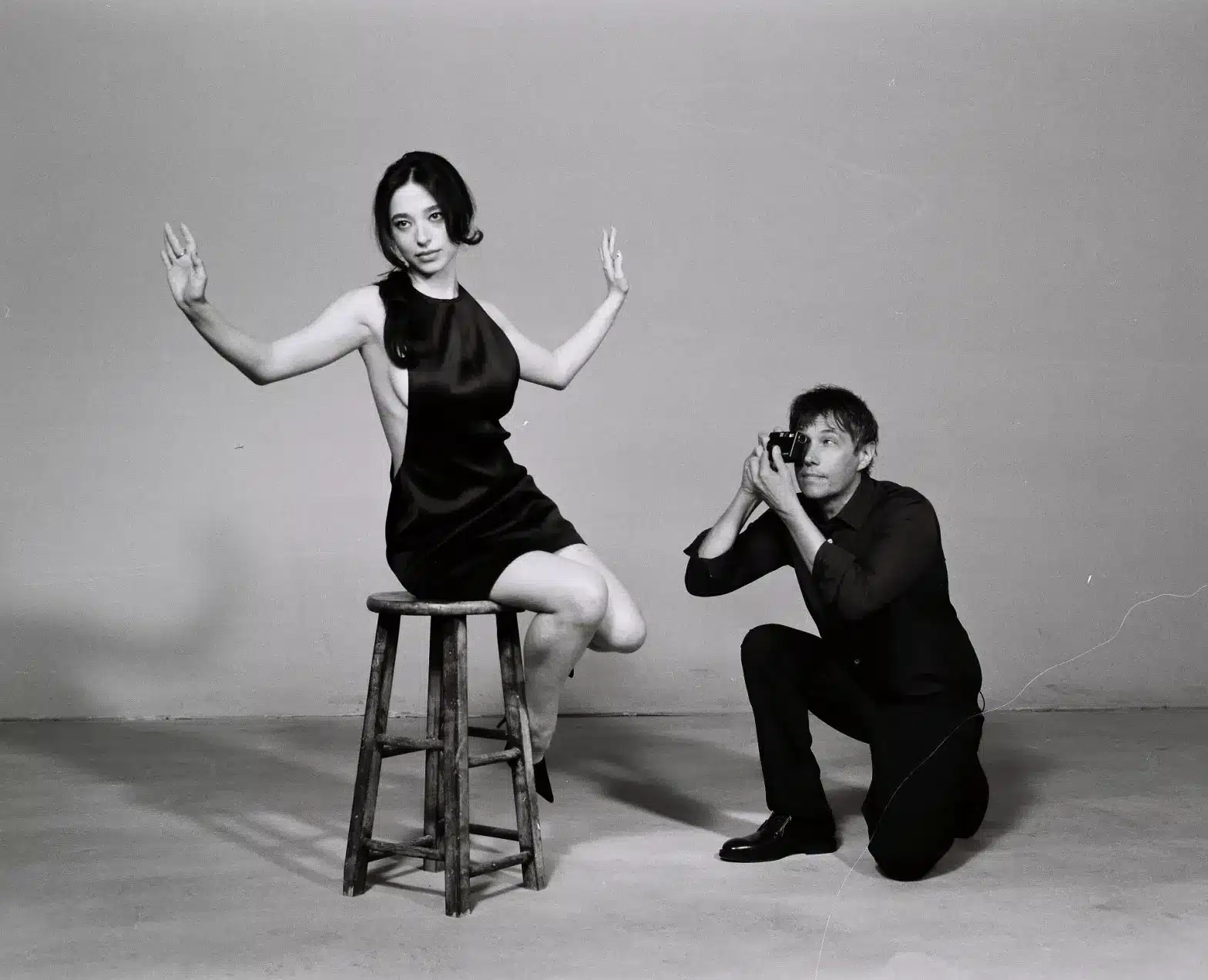

The director and lead actress of the Palme d’Or winning film discuss fleshing out the title character, shooting on film versus digital, and how they shot the film’s incredible climax.
There was a conscious shift in energy at the Palais des Congrès during the Cannes Film Festival in May, as writer-director Sean Baker triumphantly stormed the stage to claim the prestigious 2024 Palme d’Or. His latest film, Anora, had just struck festival-goers like a screen door in a hurricane, turning an admittedly monotonous edition of the festival (save for a few colourful surprises) into something truly exciting.
By the time the awards were being announced, just about everyone had an inkling that Anora would take home the Palme. Everyone except, perhaps, for Baker himself. “We never expected, in any way, the Palme d’Or,” he remembers. “In fact, I was almost convinced we wouldn’t win the Palme. And then the moment dawned, when we were the last crew standing, with one award left to give out. I went on stage and bowed to George Lucas, who had just received the honorary Palme, and after that, everything blacked out for me.”
Sitting next to Baker, his lead actress Mikey Madison laughs. “I looked over and locked eyes with Sean, and Sammy [Quan, Baker’s producer and wife] shot us both a look, like ‘Be cool, be cool’,” she says. Above all, though, the 25-year-old was just happy to enjoy the fruits of what she, Baker, and the rest of the Anora crew had crafted together. “I was already in love with our movie,” she tells me. “It was an electric feeling, to sit in the audience next to Mark [Edelstein, Madison’s co-star] who was seeing it for the first time. He would clutch my hand during certain scenes, and because I had already seen it I would constantly be looking over to him to see his reaction. That’s what made it special for me.”
Madison stars as Anora’s titular lead, a scrappy and charismatic Russian-American eking out a living as an exotic dancer at Headquarters, a strip club in Manhattan, New York. Anora’s shifts are long and nocturnal, spent giving lap dances to businessmen looking to blow a little cash, hustling potential clients into private rooms (where the pay-grade is a little higher), and navigating petty rivalries with other dancers. She clocks off at dawn, sleepily riding the train back to the small Brighton Beach apartment she shares with her sister.
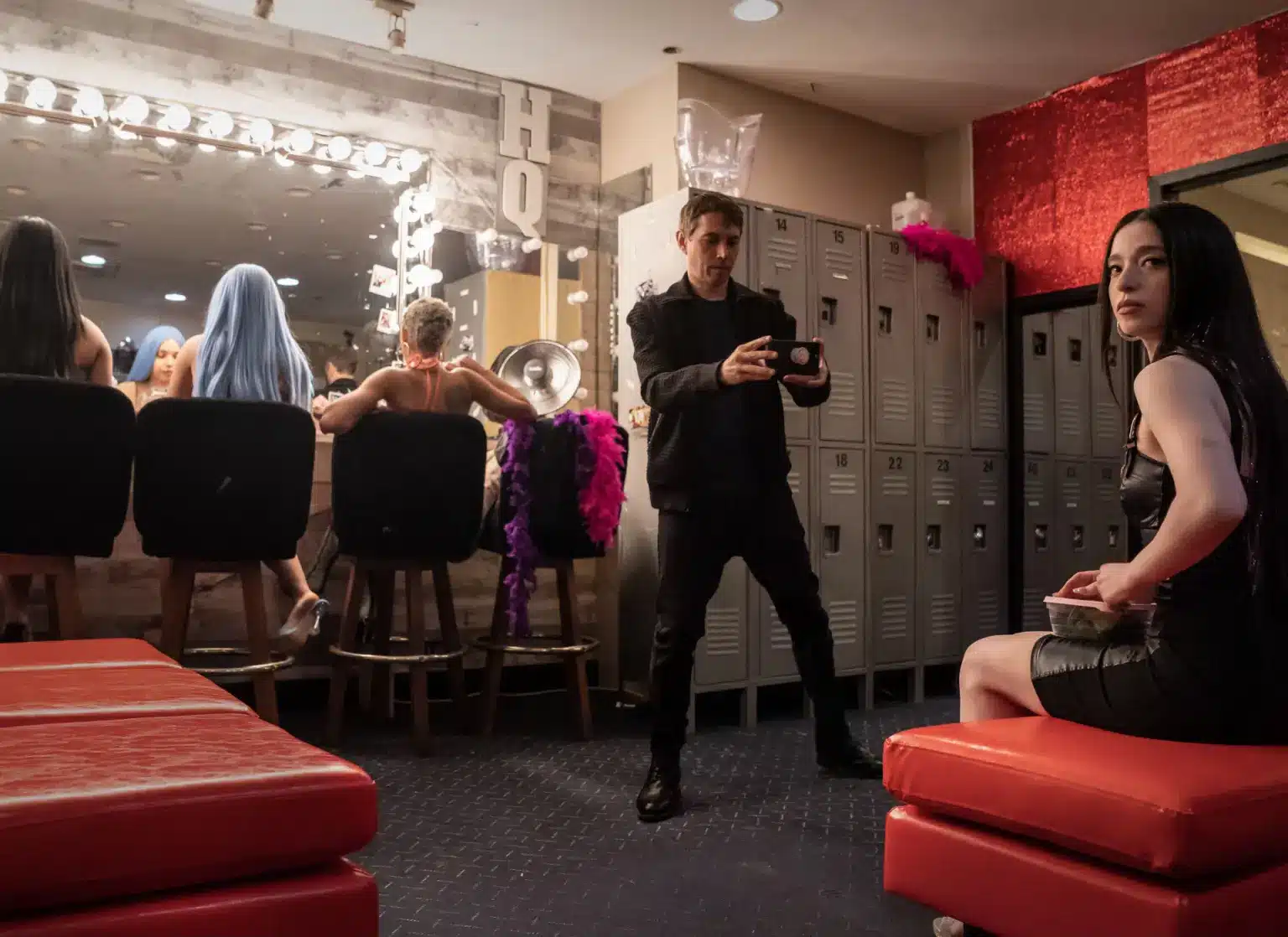
DIRECTOR SEAN BAKER AND MIKEY MADISON ON THE SET OF ANORA (2024). COURTESY OF SEAN BAKER.
But Anora’s stars seemingly change when she’s introduced to Vanya, the hedonistic son of a Russian oligarch who becomes spellbound by the dancer, subsequently offering her $15,000 to be his “horny girlfriend” for a week. Vanya’s carefree nature and boyish charm endear him to her, she happily accepts, and the Russian heir soon indoctrinates her into a lavish world of parties, private jets, and all-around decadence. After a boozy trip to Vegas culminates in the two lovebirds getting married, Vanya’s parents send three well-meaning henchmen to annul the marriage, and Anora’s fairytale comes crashing down.
Before our interview, Baker approaches me and waxes lovingly about cinema. He geeks out about the latest home media releases by Radiance and Third Window Films (“I’m a hoarder,” he admits, gesturing at an invisible stack of Blu-rays about as tall as the man himself), and the filmography of Lee Chang-dong, one of the unassailable greats of South Korean cinema, for whom we share a mutual affection, and he touches on the recent deaths of film legends like Alain Delon, Corey Yuen, and Gena Rowlands, whose performance in Gloria (1980) he cites as an inspiration for Madison’s character in the film. Meanwhile, Madison dotes playfully over her chihuahua, Jam, who takes a leisurely stroll around Los Angeles’ Sunbeam Studios as photographer Max Montgomery shoots the Anora star and filmmaker for the cover of A Rabbit’s Foot issue nine.
We sat down with Baker and Madison at Sunbeam to discuss fleshing out the character of Anora, shooting on film versus digital, the ongoing museship between Baker and Karren Karagulian, and how they shot the film’s incredible climax.
Luke Georgiades: Sean, what did you see in Mikey that you thought made her the perfect person to craft this character around?
Sean Baker: I saw Once Upon A Time in Hollywood (2019) three times in theatres, and the third time I went back specifically to watch Mikey’s scene again, because she captured my attention so viscerally. Then we watched Scream (2022), and I literally turned to Sammy in the theatre and said, “We’re going to call her people the moment we leave this theatre.” Both of those films showed me that she could do exactly all of the things I needed her to do. She could kick ass, she could scream, she had attitude. We went and had coffee, we hit it off, and I told her she’d have a script to read in three months—it took me a year. But I was picturing Mikey’s face as I was writing.
LG: What did you both learn about the nature of sex work during your research that you felt was essential to apply to this story and character? Sean, you’ve been telling stories about sex workers for a handful of movies now. How has the intentionality regarding the topic changed between Starlet and Anora?
Mikey Madison: I dove in and learned as much as I could about this world—I watched the documentaries, I listened to the podcasts, I read the books—but from the very beginning, Sean and I were adamant that this would be about one woman’s experience. The experience from the perspective of one sex worker, not every sex worker. For me, I was looking for things that would fit with Ani and that I personally related to.
SB: I’ve found such rich characters and incredible stories that have taken place in that world. There’s a million stories to be told there, and they can’t be generalised. Each one is about the individual. I never want that to be seen as being my schtick, so each time it’s about how the story can be told differently from the ones that came before it.
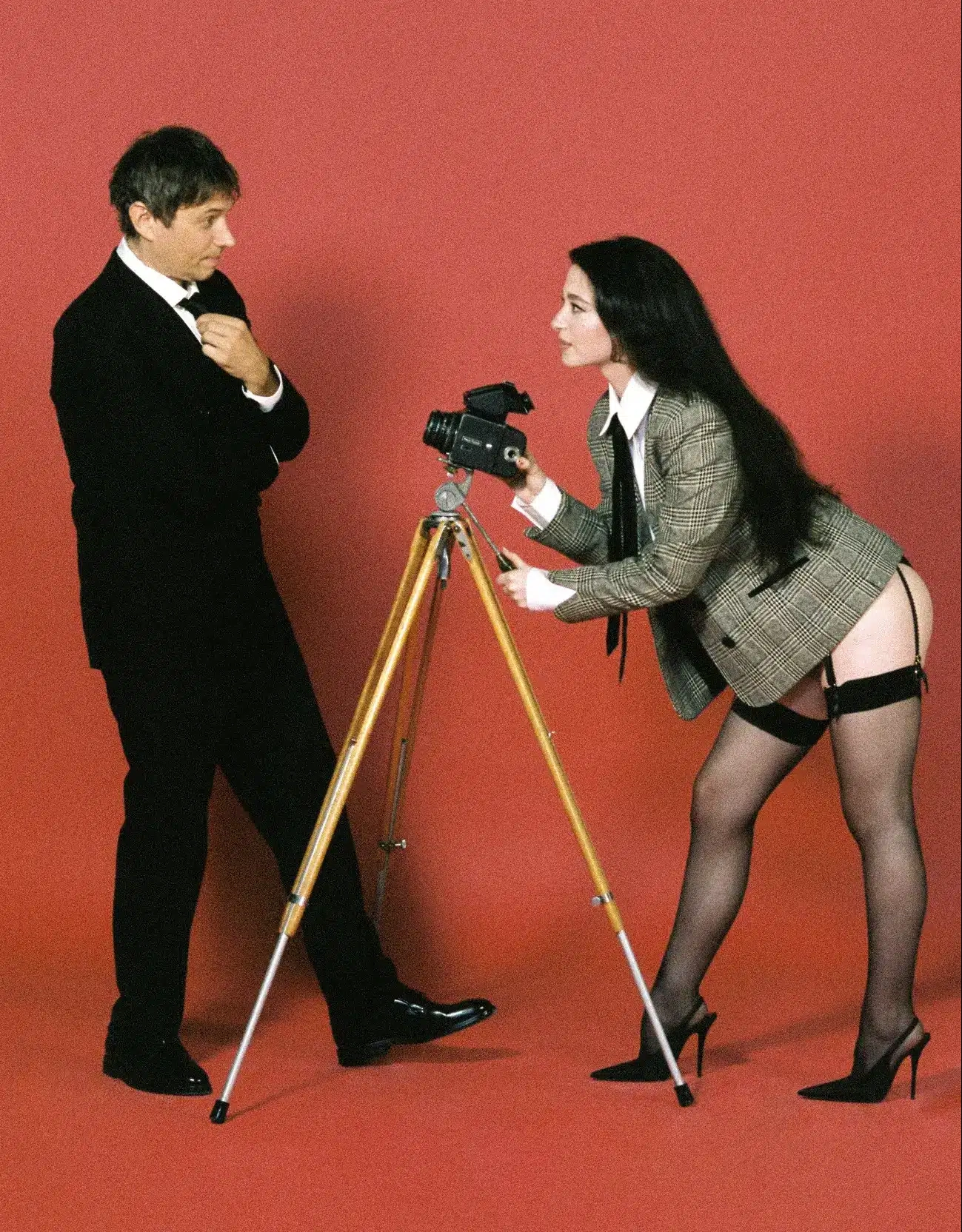
PHOTOGRAPH OF SEAN BAKER AND MIKEY MADISON FOR A RABBIT’S FOOT. LA, SUNBEAM STUDIOS, 2024. BY MAX MONTGOMERY. CREATIVE DIRECTION BY FATIMA KHAN. HAIR BY CANDICE BURNS. MAKEUP BY LILLY KEYS. PHOTOGRAPHY ASSISTANTS: MOLLY MORRISON, ALEXANDRA MOURA, ARTHUR GOLDBART. STYLING BY REBECCA RAMSEY (SEAN BAKER).
LG: Karren Karagulian has been a mainstay of yours since your debut Four Letter Words, and I was happy to see him front and centre here. Can you tell me about how you first met and your creative chemistry together?
SB: He’s a baby in that! So the producer on my first film knew Karren, and had put him in a short film that I was on as an editor. He wasn’t a trained actor, but I just thought he was so dynamic in the movie. He had this interesting look and natural charisma. So I put him in a cameo in Four Letter Words (2000), and then, years later, in Take Out (2004). After that, I realised, “God, he just shines in every little part I give him—in Prince of Broadway (2008) I’m going to make him one of the leads.” And that’s what happened. We remained close over the years. I cast him in Starlet (2012)and Tangerine (2015). Willem Dafoe told me that one of his favourite parts of making The Florida Project (2017) was working with Karren. Then I made Red Rocket (2021) in Texas, and there seemed to be no way to work him in. Like, how the hell do I get Karren in this one? But we put him in the scene where Mikey [Simon Rex] calls his porn producer back in LA to tell him that he’s found this young prospect in Strawberry. So the voice you hear on the phone is Karren as his character in Starlet. We continued the streak.
LG: And the first seeds of Anora were born from you and Karren having this interest in the Russian community at Brighton Beach.
SB: He’s an Armenian-American who came over to the US at 20 years old, his wife Lana is Russian-American—she plays his wife in Anora—and so we had always talked about wanting to make a film about the Russian community in Brooklyn’s Brighton Beach. We wrote a screenplay after Prince of Broadway that will probably never be produced because it has too many similarities to Anora, though it’s a very different movie—it’s a bunch of dudes, it’s not a female lead. We tried to get it off the ground and the script went around Hollywood. Everyone loved it and the producers who got on board said exactly what you’d expect. They were like, “Karren’s not going to be the lead, we’re going to replace the main guys with Ryan Gosling, Tom Hardy, and Matthias Schoenaerts.” I said, “Actually, this is written for Karren, he co-wrote it with me and it’s important to him,” and they said “No, no, we’re going to get you $20 million to do this our way…” I played the game for six months, and, of course, it went nowhere.
But here’s the thing: Karren had taken on this really brave role in Tangerine—it’s a queer role and homosexuality isn’t too popular in his native Armenia, so it was a risk for him, and he got some death threats on social media because of it. It’s not like we made any money on that movie, so he wasn’t necessarily compensated for his bravery—he did it for the sake of the art itself. I knew then that I couldn’t abandon this guy, that I’d do whatever it took to keep casting him. But Hollywood doesn’t write roles for actors like Karren. I tried to shop him around, and my agent at the time said, “Well, I can try and help him if he’s up for getting terrorist roles.”
He’s been my good luck charm on this whole journey. We’re friends. And so when this opportunity came up to make the Brighton Beach film we had been wanting to make, it was a no-brainer that he’d be Toros. And he finally gets to show his amazing comic chops. I wanted to make sure this movie provided that for him. Him coming out of the courthouse and yelling “Why couldn’t you have gotten married in New York?” is such a stupid sitcom line, but he grounds it perfectly.
LG: I love act two, which zones in on these different Brighton Beach establishments and the people who find patronage there. Those places and people bring the movie to life.
SB: That was the least scripted part of the whole movie. We knew these characters would hit certain restaurants, but we didn’t know what was going to happen once they got in. They were wearing wireless mics, and we’d be out on the sidewalk with a telephoto lens and we would literally just send them into these establishments. It was the most guerrilla part of the shoot, which we called The Crawl, because it’s them going from bar to bar, space to space, looking for Vanya. And we just kept on shooting. We were getting amazing stuff, because we were working with real people from the community. The older woman in the cafe who just goes, “Maybe he was kidnapped?”—that’s so specific that no screenwriter would ever think to write that, and she had no idea we were shooting until after the fact. It was very Candid Camera, but it allowed us to capture the colours of the neighbourhood. This is a diaspora story at its core and, in its rawest form, Brighton Beach encapsulates that.
LG: There are these really clear moments in the film where Anora is experiencing this conflict between her Western upbringing and her inherited Russian culture.
MM: Ani is a character who feels the highest level of every emotion, and as a result her frustration and anger builds up into this intense defiance of her culture. But there are moments, too, where she’s trying to connect with her newly wed husband, and she’s trying to tap into this language that her grandmother spoke, but she didn’t grow up speaking. In those moments her rejection of that part of herself becomes entangled with this longing to be more connected. That’s a nuanced emotion that a lot of second and third-gen immigrants will resonate with.
LG: One of the reasons you fit so well with Sean’s sensibility is because you have the same attention to detail that has become a staple in his work. You engage with the subcultures in this movie effortlessly.
MM: It was important for me to implement certain inflections to my voice and movements that a lot of these young women who work at these clubs operate in. After coming to New York for the shoot, I quickly realised that there were different etiquettes and nuances for each establishment. Some clubs might be more money-throwing clubs and others are primarily lap-dance clubs. There are little details everywhere. When you have long nails on you move your hands in a different way, and that becomes a character in and of itself. Putting on heels and figuring out your walk is part of existing in that world. I didn’t want to leave a single stone unturned when it came to building this character. Ani’s too important to me for her not to feel fully realised and lived in.
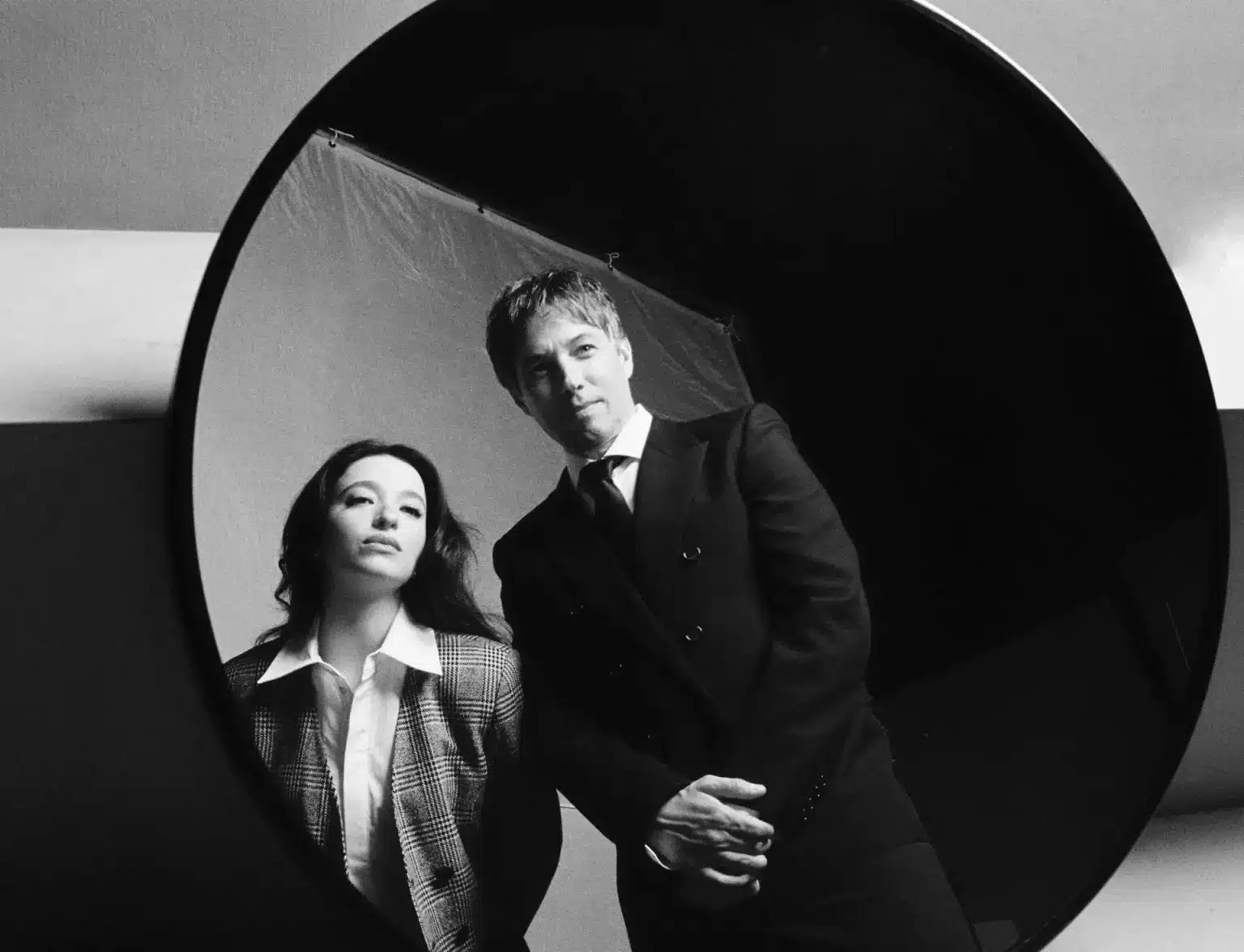
PHOTOGRAPH OF SEAN BAKER AND MIKEY MADISON FOR A RABBIT’S FOOT. LA, SUNBEAM STUDIOS, 2024. BY MAX MONTGOMERY. CREATIVE DIRECTION BY FATIMA KHAN. HAIR BY CANDICE BURNS. MAKEUP BY LILLY KEYS. PHOTOGRAPHY ASSISTANTS: MOLLY MORRISON, ALEXANDRA MOURA, ARTHUR GOLDBART. STYLING BY REBECCA RAMSEY (SEAN BAKER).
SB: It was really apparent in the opening scene, where we’re seeing a day in the life of Anora. We had this club up and running—we had our actors, our dancers, we had one of our producers DJing, and in a very Altman-style we were following Mikey around from person to person, whether it was her talking to a friend or interacting with a client. We’d give her a minute with each person, and then radio into her ear “OK, move to the next” and she’d move on. But that was incredible, because that’s a 10-minute magazine on that 35mm, and we ran three of them, so we were shooting Mikey going around in character holding her own for a good 30 minutes straight.
MM: That was maybe my favourite day of filming. Having this live set, having no idea where one conversation is going to take you. I had gotten to know a lot of the girls in the club, so we had already built these relationships with each other. Each person was their own character.
SB: I loved watching you take on Ani’s hustle, and how that changed ever so slightly between each client. The way you’d drag one guy to the ATM, very blatantly like “Let’s get your money”, and another guy you’d be very gentle with, like “Oh, you’re a hard worker? Yeah? You wanna go to a private and tell me about it?” [laughs] Because that’s what someone in Ani’s position needs to do. It’s a skill to be able to adjust the hustle accordingly, and Mikey was very aware of giving us a version of each possible scenario.
MM: I do want to say: exotic dancing is truly one of the most complex jobs in the world. It’s emotionally and physically demanding—you’re having to move your body in a certain way, be extremely athletic all night long, and at the same time emotionally connect with other human beings. Sometimes you’re a therapist, sometimes you’re a girlfriend. I have a lot of respect for dancers—just the little sliver of what I experienced would leave me exhausted by the end of the day.
LG: Anora experiences this wave of cathartic emotional release at the end of the film. How did you go about reaching the emotional place that was necessary for that moment?
MM: We talked about this scene for a long time. I kept seeing it on the shooting schedule, and it would make me physically sick to imagine myself performing it. It’s the last scene in the movie, and I had this picture in my head of how I wanted it to go, and I didn’t want to fuck that up or fuck the movie up. I put a lot of pressure on myself. During filming I found myself feeling very guarded—I never let myself cry, which is strange because in my personal life I’m very sensitive, very emotional. I think, internally, I was subconsciously projecting a lot of the same things that I knew Ani would be feeling.
So we tried to shoot it a couple of times, but something always got in the way. The weather wasn’t right, the snow didn’t look good, so there was this big build-up to this scene where I was like “Fuck, I better get it right!” But weirdly enough, that internal frustration I felt trying to shoot the scene ended up speaking perfectly to what Ani was feeling at that point in the story. Yura also helped bring me to that place. Looking into those piercing eyes of his was a soulful experience. He helped me reconcile my emotions with the emotion of my character.
LG: Was that meticulously choreographed? Because each minute movement from you and Yura feels totally consequential to how that scene plays out.
SB: It had to be planned down to the millisecond: when the camera was going to push in, how the snow would build on the window of the car. I wanted them to be encased in this cave of snow. It was a stressful process. For me, endings are the most important thing. We talked a lot about intention and motivation, but there was a point where Mikey actually said, “I don’t know if we’ll ever be able to define this for ourselves, because I don’t even think that Ani is fully conscious of why she’s doing this.” That put me at ease. That made me think, OK, we don’t have to define it completely, we’ll all have our own interpretation and that’s what will make it special.
LG: Anora is a screen heroine in the truest sense. What kind of movies did you watch to prepare to bring the character to life?
SB: There were films that inspired the vibe, like Female Prisoner #701: Scorpion (1972) for Meiko Kaji’s strong and sensual kickass character. But I also realised that Mikey’s a cinephile too and our sensibilities are similar; we find humour in the same stuff. She told me she watched Tangerine five times, which is cool. And I knew that the humour in Anora was closest to Tangerine out of all my films, so I knew she knew where I was trying to go with the film.
MM: The Bride from Kill Bill (2003) is a solid one for me. She was one of the first badass, almost superhero-like female characters that I ever fell in love with.
SB: That’s a great one. Gena Rowlands’ titular character in Gloria. I saw it at nine years old-
MM: [laughs] What??
SB: -on HBO, and her pointing that 38mm pistol into the lens of the camera stuck with me. That was the first street-level, badass woman with a New York attitude that I had seen on screen. I think there’s a lot of DNA from Rowlands that made its way into Anora. Nights of Cabiria (1957)too, a Fellini film which totally inspired this film. Giulietta Masina in that movie… it’s one of the earliest cases I can see which features a truly empathetic approach to sex work. That was decades ahead of its time. I consider that one of the great films about sex work.
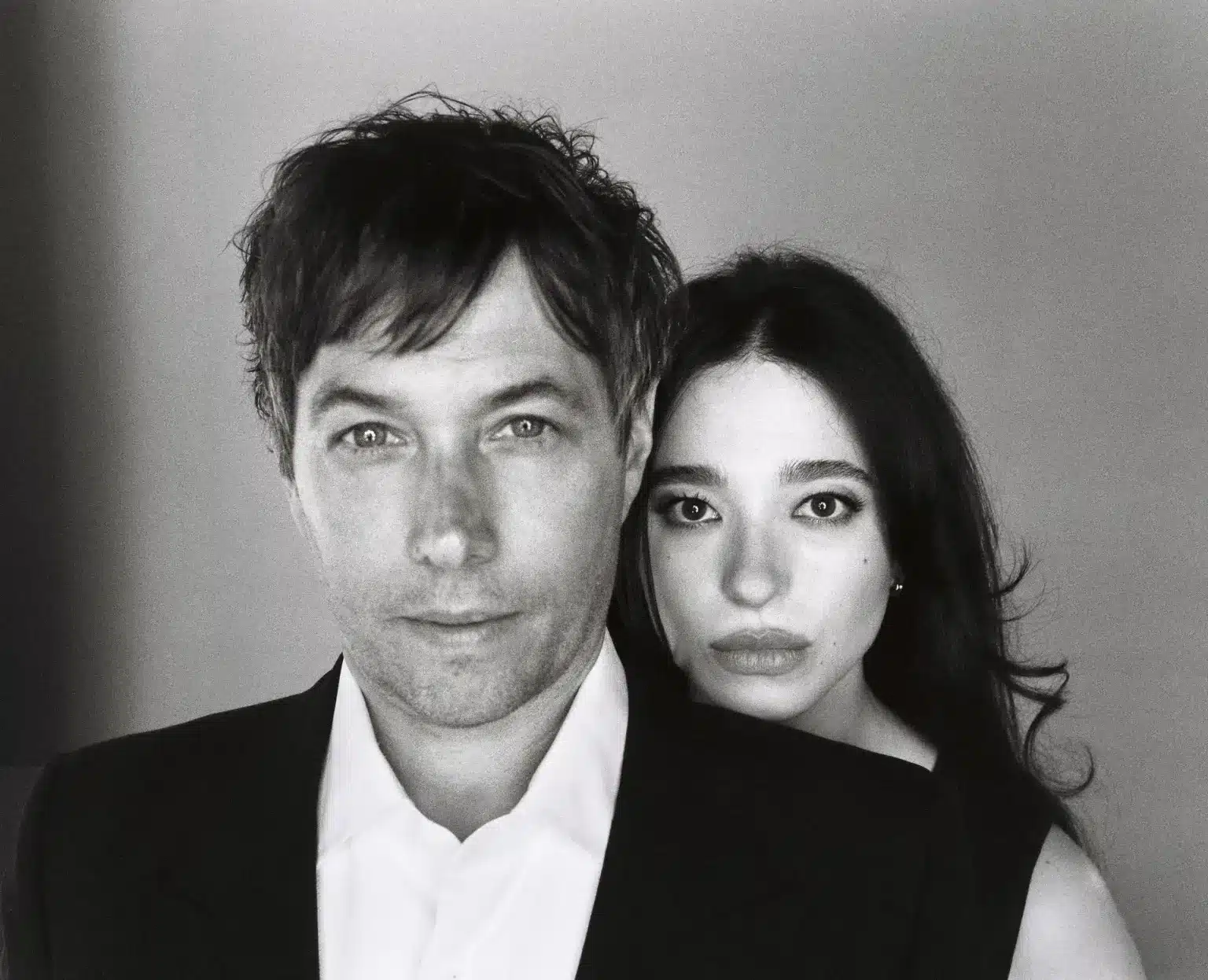
PHOTOGRAPH OF SEAN BAKER AND MIKEY MADISON FOR A RABBIT’S FOOT. LA, SUNBEAM STUDIOS, 2024. BY MAX MONTGOMERY. CREATIVE DIRECTION BY FATIMA KHAN. HAIR BY CANDICE BURNS. MAKEUP BY LILLY KEYS. PHOTOGRAPHY ASSISTANTS: MOLLY MORRISON, ALEXANDRA MOURA, ARTHUR GOLDBART. STYLING BY REBECCA RAMSEY (SEAN BAKER).
LG: There are stamps of your authorship here that will be recognisable to audiences. You bring back your signature opening needledrop, for example, with Greatest Day. I’m only now learning that Take That are virtually unknown in the States, but I think it will play very well with British audiences.
SB: Thank you! I’m very happy about that. We actually didn’t choreograph that opening sequence with that song. There were two other songs that were poppy and known and quite fun, but there was something about this Greatest Day song that we had found in post, that just summed up the entire movie thematically. I knew Take That from that hit they had in the 1990s, Back For Good, but this song was a discovery for us, so it was great to realise it was number one in so many European countries and actually had this fun cultural significance over there. It was serendipity, when I first dropped the song on the opening credits, the beat perfectly matched with the title cards appearing. Then we were able to edit the middle montage—what we call “the marital bliss” montage—to that song, which was basically like shooting a music video, and, again, the beats of the song matched up with the beats of the scene perfectly. We were jaw-dropped—it was as if Take That had written Greatest Day specifically for the movie itself.
LG: There are also elements here that feel like a departure from your previous style. Some of the comedy sometimes feels slapstick in a way that feels new for you.
SB: I had been trying to get to a place where I could make an 80s-style, John Landis, Robert Zemeckis-doing-Used Cars comedy. I feel like we’ve gotten to a place that’s so far away from that sort of humour in movies: a little more dangerous, but still laugh-out-loud. I’ve been trying to get there, and I’ve been taking baby steps. In the next one it’ll be even more broad and comical. It’s a balancing act with the movies I make, because I’m known as a social-realist director, so to inject humour you have to be delicate and rely more on subtle, behavioural humour to set up a punchline. I wanted to mash up genres here—I wanted it to turn from a romantic comedy into a thriller into a Russian arthouse film by the end. [Laughs] I wanted it to be Tarkovsky by the end of the film. After doing Red Rocket and realising I could make something that was a rollercoaster of tones, I wanted to see how far I could take that.
LG: Do you feel like that social-realist label has held you back in that regard?
SB: It’s interesting about social realism: it morphed into something extremely serious, but go back far enough and there was stuff that was almost slapstick. Look at Ken Loach’s Kes (1969), and the football scene where it’s just this crazy coach screaming at children. It’s amazing. And then later on he made Riff-Raff (1991), where a family is scattering these ashes at a funeral and a gust of wind blows a cloud of this ash back in their faces. I love that part of social realism, and I want to get back to that.
LG: You have a very specific recurring type that has become a staple in your filmmaking. Can you tell me about the origin of that?
SB: I took cues from John Carpenter and Woody Allen, where they had made these fonts their signatures.. I came across this font with Tangerine, and it felt right to keep it going. I had some pushback at the time, some people thought it actually made the films less original. But I hope people have come to expect something with that font.
LG: We do, to the point where it seems to align thematically with your movies.
SB: I hear you. It’s a sophisticated script type against this down and dirty subject matter. It’s the juxtaposition. Strangely enough, recently, when we were restoring Starlet, we were playing around with the idea of swapping the title font with the one we use now, and we put it on the opening title sequence…and it doesn’t work. There’s something about it that doesn’t work, and I think it’s because we had Dree Hemingway, this model, who already looks so groomed and sophisticated—it almost matched her and the film too well.
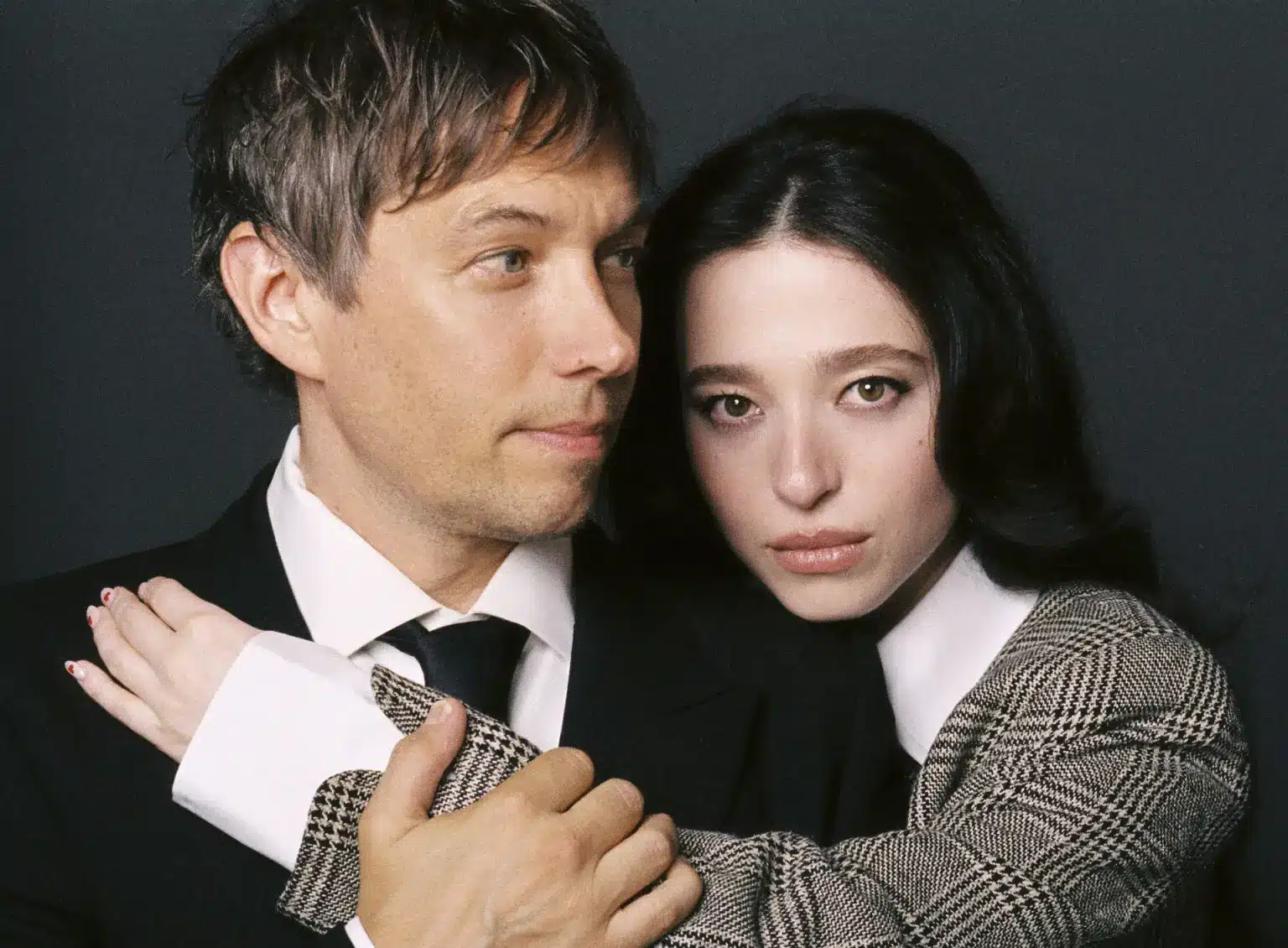
PHOTOGRAPH OF SEAN BAKER AND MIKEY MADISON FOR A RABBIT’S FOOT. LA, SUNBEAM STUDIOS, 2024. BY MAX MONTGOMERY. CREATIVE DIRECTION BY FATIMA KHAN. HAIR BY CANDICE BURNS. MAKEUP BY LILLY KEYS. PHOTOGRAPHY ASSISTANTS: MOLLY MORRISON, ALEXANDRA MOURA, ARTHUR GOLDBART. STYLING BY REBECCA RAMSEY (SEAN BAKER)
LG: You’ve proved in the past that a lower budget can also breed innovation. Tangerine and Take Out are perfect examples of that. What was it like working with a bigger budget on this film?
SB: It was about finding the people who understood how I wanted to make films, and always being aware that no matter how much money you’re given to make a movie, don’t spend it all on lattes or trailers. Put the money on the screen. Keep your independent, guerilla hat on while making your movie. I won’t name names, but some of the studios that seem independent in Hollywood are absolutely throwing money at projects. The budgets and unnecessary costs are outrageous. Anora’s budget was only a little more than Florida, but we made sure that every cent was going to be on screen. I can’t get much bigger budgets than this. Mikey Madison is going to be a star, that’s guaranteed, but when you’re trying to pitch and get money, and the only Hollywood name you have is Mikey Madison, they’ll say, well, why don’t you get Emma Stone? That’s the nature of Hollywood. “You want to bring in Russian stars? During this war with Ukraine? Really?” But it was motivation for us: to prove that we could make a film that audiences wanted to see without those same 10 A-list stars. Everything’s a challenge: shooting on film, at all those locations… My production team really had to understand how to stretch a buck. We’re still begging, borrowing, and stealing. We’re literally stealing shots sometimes, I don’t care if people know that. That’s part of the fun… we had to steal that shot on Fifth Avenue—that classic shot of Mikey and Mark walking down Fifth with a sea of people around them. Know how much that would have cost if we had to get permits for that, to set up, to block off the streets? No, we just had to show up on the corner, get that tripod up, shoot the shot, and get out of there before we got shut down. Every time we finish one of these movies, Hollywood comes our way and they’re like, “Cool! The next time out we’re going to have trailers, all the bells and whistles and amenities” and I’m like, “No, we don’t want that, that’s stopping us from actually giving you quality.” If I tried making my films in ultra-comfortable conditions, it wouldn’t translate.
LG: Is it paramount for you to shoot on film right now?
SB: Absolutely. So much so that we purchased two cameras—an ARRI LT 35mm, and a 16mm ARRI SR3—knowing that we’d be shooting on film for the rest of my career. On occasion it’s necessary to shoot on digital in order to get a nighttime shot, but even then, I’ll transfer the digital into film and then back again, putting it in the celluloid world so it’s not just a bunch of ones and zeros. I want to celebrate the medium that was responsible for creating this artform. I don’t want it to go away just because we have digital at our fingertips. Film gives you an image that you can come close to matching on digital, but can’t quite be accomplished—I don’t care what anybody else says. Deakins comes extremely close but, for me, it gives you an image that’s unmatched. It’s also the preservation: knowing I have a negative that, in the event of an electric pulse tomorrow that wipes out our hard drives, I have in my storage. And then there’s the discipline that happens on set when you tell actors that you’re shooting on film. Their faces light up. Because suddenly your actors are feeling the pressure now. They know it’s a 10-minute mag, and we’ll be calling cut no matter what when that time runs out. It’s about delivering in the moment, and having a finite amount of chances to do so. I remember Mikey’s smile when I told her, because she remembers shooting on film during Once Upon A Time, so she knows how special that is.
I don’t want to shit on digital because I’ve shot four of my films digitally. My biggest budget of those four films was Starlet, which we shot for $247,000, so we literally could not have shot on film. With Tangerine, I thought, “We can’t shoot on film, so why don’t we aim for an aesthetic that wouldn’t be achievable on film?” That’s how we ended up with the no-depth-of-field, crazy lo-fi iPhone. I loved that, too. So I never want to discourage young filmmakers from picking up an iPhone and shooting. But I never want to shoot on digital and emulate film. If you have the means, shoot on film, it’ll elevate your project. Whether someone knows it or not, the classic film look will be felt unconsciously. After 100 years, we connect that look with what cinema is in its purest form.

